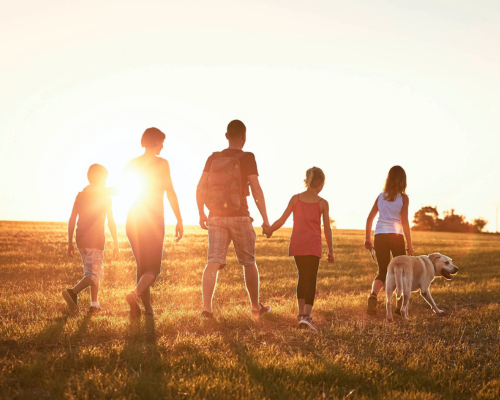Build a mindful summer for kids with these focused activities.
Mindfulness means children can concentrate without anything else distracting them. Everyday life stress can overwhelm and make it difficult for children to reflect and observe what is happening around them. Mindfulness can be lost in a world that continues to move faster than ever and wherein children are constantly engaged with screens and digital media.
Until it is woven naturally into your child’s day, mindfulness activities and exercises help develop their mindfulness muscle. This bucket list of summer activities will build your child’s mindfulness while creating further shared connections and memories.
A Sunrise Mindful Walk
Rise with the sun to take a mindful walk with your child. Remind them the walk is about the journey and the awareness it brings them, not the destination. Encourage them to notice the physical sensation, the scented air and the breeze as they walk. Besides its physical benefits, walking can also improve mood and mental relaxation.
Make a Mind Jar
Create a mind jar together with a jar, glitter glue, water and food coloring. Once assembled, it can be used as a mindfulness tool to help ground a stressed, anxious or upset child. Encourage them to imagine the glitter as their thoughts. When the jar is shaken, so is the glitter, but it calms with rest. Teach them that their whirlwind of emotions works identically.
Enjoy a Silent Meal
Caregivers, it might have been a while since you last had a quiet meal, but we encourage you to give it a go. Explain to your child that part of the next meal will be eaten in silence. Encourage them to concentrate solely on the experience of eating (though we know how easy it is for little ones’ minds to wander). Encourage them to use all their senses to notice how the food tastes, smells and sounds — maybe they can hear the crunch of their vegetables.
Starfish Breathing
Breathing exercises benefit everyone, regardless of age, and this simple trick teaches kids how to take deep breaths. Have them spread out their fingers on one hand, palm up. Using a finger from the other hand, ask them to inhale as they trace their finger around their upheld hand, releasing the breath once they’re done. Adults, make sure you try it too. Deep breathing helps reset your body and regulate and calm stress.
Pleasure Gazing
Pleasure gazing allows us to concentrate on one thing while our mindfulness does the rest. The main idea behind pleasure gazing is to take notice of the details and unique characteristics of someone you love. Sit opposite your child, and set a short timer. While it counts down, you both take in the individual elements of each other’s faces. You may notice a new freckle, while your child might take in the way your face shifts when you smile. If they struggle to do this with you, encourage them to try it with their favorite stuffed animal and see if they can notice something new.
The Popsicle Challenge
On a hot day, when your child is eating a Popsicle, challenge your kid to be silent until their Popsicle is entirely gone. Encourage them to notice all the different tastes. (One of those three-flavor Popsicles would be great for this.) Challenge them to talk when you all finish the challenge.
Afterward, ask them: What flavors did they notice? Did the Popsicles start to feel different in their mouths as they melted? What temperature changes did they notice? Was it hard to stay quiet the whole time? What was the best part of the Popsicles?
Body Scan
Our bodies often set off warning bells or alerts related to our mental health, but we sometimes miss their cues. A body scan provides insight through mindful listening and observation. Sit or lie down with your child and separately concentrate on your body parts one at a time. Start with your toes and work your way up your body.
Encourage the child to name what they feel as they progress. Tired knees, a swirly stomach or a drooling mouth can all be explored. Draw connections: Soccer practice accounts for tired knees, an upcoming spelling test for the stomach and hunger for the mouth. Caregivers should complete the same exercise to set an example. Reflect on what your own body tells you about your physical and mental health.
Hike on a New Trail
Combine adventure with a serotonin-boosting workout as you hit a new trail. Novel experiences carve more robust pathways in our brains, while spending quality time in the great outdoors reduces stress, calms anxiety and can lead to a lower risk of depression, according to a study done by researchers at Stanford University.
On your hike, try to notice your breathing, walk more slowly than usual, and look between the branches and leaves to behold the light.
Dance Party!
Crank up the tunes and dance! Get out of your head and into your body. I love dancing with kids — there’s no self-consciousness involved. We can learn a lot from the way kids dance: It’s just pure movement and joy and self-expression.
Anthony Cupo is a trained mindfulness facilitator (TMF) from the UCLA Semel Institute for Neuroscience and Human Behavior. He is a co-owner of Stepping Forward Counseling Center, LLC, and has been meditating for over 30 years.











Leave a Reply